The Saké Brewing Process
Saké brewing
Saké is produced by the multiple parallel fermentation of rice
Rice Polishing
Good saké rice (sakamai) differs from the “table” rice we eat in many ways. One of the most distinguishing characteristics of sakamai is the shinpaku (“white heart”) in the center of the grain, in which the starches are concentrated. Surrounding the shinpaku, toward the outer edges of the grain, are fats, proteins, and minerals that inhibit fermentation and can cause off flavors in saké, so before the rice is used in brewing, it must be polished to the desired level using large, computer-monitored rice-polishing machines.
Rice Washing and Soaking
After the rice has been polished to the desired degree, it must be washed to remove the powder left over from the polishing process. The rice is then soaked in water to prepare it for the steaming process. This is a crucial step in the brewing process, because the water content in the rice prior to steaming can significantly impact the condition of the resulting steamed rice. Highly polished rice used in premium saké production is soaked in small batches to a very precise degree, and soaking time is measured with a stopwatch to ensure the rice achieves the proper water content.
Steaming the Rice
The rice is steamed to make it the proper consistency for the koji to be able to work its magic in the next step. Note that the rice is not mixed with water, but rather blasted with steam that is directed so that it flows through the rice evenly.
Koji Production
Koji production is often called the heart of the saké brewing process, and it takes place in a special room in which the temperature and humidity are strictly controlled. Koji is steamed white rice onto which the koji-kin (koji mold) has been cultivated. This mold works its way into the rice grains, releasing enzymes as it does, to convert starch to sugar (a process known as saccharification). Later on, yeast will be added to convert the sugar to alcohol and carbon dioxide during fermentation.
Yeast starter (Moto or Shubo)
Yeast will work with the koji to convert sugar to alcohol, but in order for the yeast cells to survive in the bacteria-laden atmosphere, a small tank with a high concentration of yeast cells is prepared. To do this, koji, steamed rice, and water are mixed in a small vat, and to this mixture a culture of pure yeast cells are added. In addition, a small amount of lactic acid is usually added at this stage to protect the yeast cells from airborne bacteria. Over the next two to three weeks, the koji breaks down the starches in the rice to provide food for the yeast cells. The yeast cells, in turn, rapidly multiply until the mixture is stable enough to have larger amounts of koji, steamed rice, and water added to it. At full strength, there can be as many as five million yeast cells in a teaspoon of the yeast starter.
This mixture is called moto. To underline the importance of this step, the yeast starter is also referred to as shubo, whose kanji can literally be translated as “mother of saké.”
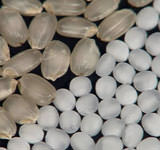
Unpolished and polished rice
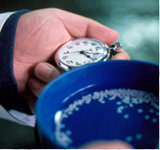
Timing the soaking of rice
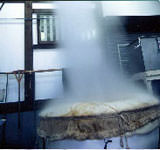
Steamed rice

Sprinkling koji spores on rice
Main Mash (Moromi) and Multiple Parallel Fermentation
The moto is then transferred to a larger vat, where steamed rice, koji, and water are added three times, typically, over a four-day period. Now, the main mash is called the moromi. The moromi sits and ferments for a period of between 18 and 32 days, during which time the conversion from starch to sugar (saccharification), and the conversion from sugar to alcohol and carbon dioxide (fermentation) take place in the same tank simultaneously. This process of “multiple parallel fermentation” is unique to saké brewing, and the resulting 20% alcohol by volume gives saké the distinction of having the highest naturally occurring alcohol content of any fermented beverage in the world. (Note: Most saké is diluted back down to 15-16% alcohol before shipping by adding water.)
Pressing
When the moromi is finished fermenting, it is pressed through a mesh to separate the sake from the remains of the fermented rice, or lees, known as kasu. Though there are several time-honored methods used to press saké, at most breweries this is achieved by pumping the moromi into a large machine resembling an accordion, which fills with air and squeezes the moromi through several mesh panels.
Filtration
After the saké sits for roughly ten days, and the sediments have settled, the saké can be filtered by adding powdered carbon to the saké, and running the resulting black mixture through a filter. During this step, unwanted flavor elements and natural amber coloring can be removed, but the brewer must also take care not to strip away too many of the saké’s distinctive elements. Many premium brewers opt to not filter at all, displaying confidence that great rice, water, and brewing skill make this step redundant.
Pasteurization
Most saké is pasteurized twice – once before storage, and once again before shipping. Pasteurizing the saké deactivates enzymes and kills bacteria that could adversely affect the saké after it has left the brewery.
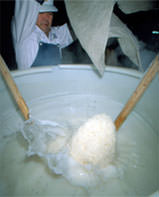
Adding steaming rice to the mash
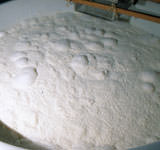
A fermenting tank
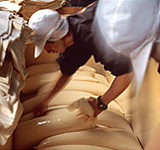
Placing saké mash-filled bags in an old-fashioned press. A lid is cranked down on the top, and the clear saké runs out the bottom.
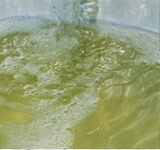
Freshly pressed saké
Saké is produced by the multiple parallel fermentation of rice
Rice Polishing
Good saké rice (sakamai) differs from the “table” rice we eat in many ways. One of the most distinguishing characteristics of sakamai is the shinpaku (“white heart”) in the center of the grain, in which the starches are concentrated. Surrounding the shinpaku, toward the outer edges of the grain, are fats, proteins, and minerals that inhibit fermentation and can cause off flavors in saké, so before the rice is used in brewing, it must be polished to the desired level using large, computer-monitored rice-polishing machines.
Rice Washing and Soaking
After the rice has been polished to the desired degree, it must be washed to remove the powder left over from the polishing process. The rice is then soaked in water to prepare it for the steaming process. This is a crucial step in the brewing process, because the water content in the rice prior to steaming can significantly impact the condition of the resulting steamed rice. Highly polished rice used in premium saké production is soaked in small batches to a very precise degree, and soaking time is measured with a stopwatch to ensure the rice achieves the proper water content.
Steaming the Rice
The rice is steamed to make it the proper consistency for the koji to be able to work its magic in the next step. Note that the rice is not mixed with water, but rather blasted with steam that is directed so that it flows through the rice evenly.
Koji Production
Koji production is often called the heart of the saké brewing process, and it takes place in a special room in which the temperature and humidity are strictly controlled. Koji is steamed white rice onto which the koji-kin (koji mold) has been cultivated. This mold works its way into the rice grains, releasing enzymes as it does, to convert starch to sugar (a process known as saccharification). Later on, yeast will be added to convert the sugar to alcohol and carbon dioxide during fermentation.
Yeast starter (Moto or Shubo)
Yeast will work with the koji to convert sugar to alcohol, but in order for the yeast cells to survive in the bacteria-laden atmosphere, a small tank with a high concentration of yeast cells is prepared. To do this, koji, steamed rice, and water are mixed in a small vat, and to this mixture a culture of pure yeast cells are added. In addition, a small amount of lactic acid is usually added at this stage to protect the yeast cells from airborne bacteria. Over the next two to three weeks, the koji breaks down the starches in the rice to provide food for the yeast cells. The yeast cells, in turn, rapidly multiply until the mixture is stable enough to have larger amounts of koji, steamed rice, and water added to it. At full strength, there can be as many as five million yeast cells in a teaspoon of the yeast starter.
This mixture is called moto. To underline the importance of this step, the yeast starter is also referred to as shubo, whose kanji can literally be translated as “mother of saké.”

Unpolished and polished rice

Timing the soaking of rice

Steamed rice

Sprinkling koji spores on rice
Main Mash (Moromi) and Multiple Parallel Fermentation
The moto is then transferred to a larger vat, where steamed rice, koji, and water are added three times, typically, over a four-day period. Now, the main mash is called the moromi. The moromi sits and ferments for a period of between 18 and 32 days, during which time the conversion from starch to sugar (saccharification), and the conversion from sugar to alcohol and carbon dioxide (fermentation) take place in the same tank simultaneously. This process of “multiple parallel fermentation” is unique to saké brewing, and the resulting 20% alcohol by volume gives saké the distinction of having the highest naturally occurring alcohol content of any fermented beverage in the world. (Note: Most saké is diluted back down to 15-16% alcohol before shipping by adding water.)
Pressing
When the moromi is finished fermenting, it is pressed through a mesh to separate the sake from the remains of the fermented rice, or lees, known as kasu. Though there are several time-honored methods used to press saké, at most breweries this is achieved by pumping the moromi into a large machine resembling an accordion, which fills with air and squeezes the moromi through several mesh panels.
Filtration
After the saké sits for roughly ten days, and the sediments have settled, the saké can be filtered by adding powdered carbon to the saké, and running the resulting black mixture through a filter. During this step, unwanted flavor elements and natural amber coloring can be removed, but the brewer must also take care not to strip away too many of the saké’s distinctive elements. Many premium brewers opt to not filter at all, displaying confidence that great rice, water, and brewing skill make this step redundant.
Pasteurization
Most saké is pasteurized twice – once before storage, and once again before shipping. Pasteurizing the saké deactivates enzymes and kills bacteria that could adversely affect the saké after it has left the brewery.

Adding steaming rice to the mash

A fermenting tank

Placing saké mash-filled bags in an old-fashioned press. A lid is cranked down on the top, and the clear saké runs out the bottom.

Freshly pressed saké
Saké Nomi’s free newsletter, Nomidachi News, contains informative saké-related articles, as well as news about upcoming events and special promotions.
Hours
Tuesday-Thursday: 2pm - 8pm
Friday-Saturday: 2pm - 10pm
Please follow us @ website, Twitter, Facebook, Instagram
Home
Saké Basics
Nomidachi News
Sake Nomi Events
Contact Us
Sake Nomi Copyright © 2016. All Rights Reserved
iBleedPixels Hand-crafted in Kochi City, Kochi Japan.